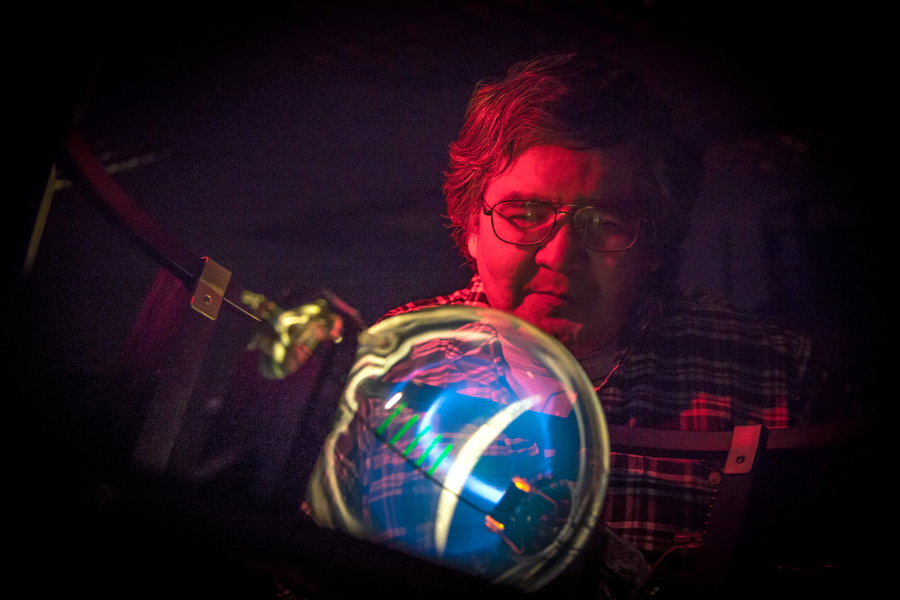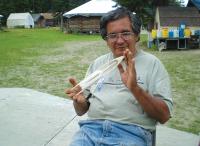A Launching Pad for a Scientific Mind
Fall
2014
Special Feature
A Launching Pad for a Scientific Mind
Physicist Stanley Edwin Integrates Traditional Alaska Native Knowledge With Western Science
By:Leona Long
University of Alaska-Fairbanks

When Apollo 13’s oxygen tank ruptured, residents of the small Alaskan village of Chalkyitsik gathered in church to pray for the mission’s success. Spellbound, young Stanley Edwin huddled with his family by a crackling transistor radio. He wanted to walk on the Moon like astronauts Neil Armstrong and Buzz Aldrin.
“I clearly remember the first Apollo launch, even though I was only about 2 years old,” says Edwin. “I was fascinated by outer space and the stars, my ancestors’ campfires in the sky.”
The 1960s rocket blastoffs propelled Edwin’s curiosity. He wanted to know more than what the people around him could explain. His father was a wise man and chief of the Dranjik Gwich’in people, but this wise man’s experiences and knowledge were specialized for living and surviving in the boreal forest of Alaska’s interior. He could not satisfy his son’s questions of why and how.
Decades later, Edwin is finally finding the answers to his childhood questions by studying what he calls “the science of nature,” aka applied physics, at the University of Alaska Fairbanks (UAF). His work at the National Center for Atmospheric Research in Boulder, Colorado, won an Outstanding Presentation Award at the 2013 national conference of the Society for Advancement of Chicanos and Native Americans in Science. This summer, he participated in the International Comparative Rural Policy Studies consortium program, which studies rural policy and how to protect rural environments.
“In traditional ways of knowing, we don’t break things down and categorize them. We see the interconnection of things and how things affect each other,” explains Edwin, who graduated with his bachelor’s degree in December 2013. “In the Alaska Native way of knowing, nothing stands alone.”
As a member of UAF’s SPS chapter, one of Edwin’s favorite activities was judging science fairs and performing physics demonstrations for elementary school students. “My own curiosity is always reinforced by the children’s inquisitive hunger. They want to know how a demonstration works,” says Edwin.
 Edwin’s path to higher education has been paved with ice. His first winters as a UAF student began at 6 am with a three-mile walk to the university’s rural center in Fort Yukon for construction trades technology classes. The bone-chilling temperatures dipped down to 50 below. After his evening classes ended, he walked the three miles back to his home and pondered the questions whose answers had eluded him as a child. This routine continued for several winters until he earned two associates of applied science degrees and a bachelor's along the way.
Edwin’s path to higher education has been paved with ice. His first winters as a UAF student began at 6 am with a three-mile walk to the university’s rural center in Fort Yukon for construction trades technology classes. The bone-chilling temperatures dipped down to 50 below. After his evening classes ended, he walked the three miles back to his home and pondered the questions whose answers had eluded him as a child. This routine continued for several winters until he earned two associates of applied science degrees and a bachelor's along the way.
Now Edwin asks more sophisticated questions during his walk to the university. As a graduate student at UAF’s Geophysical Institute, he is continuing his studies in atmospheric science and physics. He is conducting an independent research project at the International Arctic Research Center in Fairbanks, investigating funnel clouds in Alaska, the precursor to tornadoes.
“I always question and seek answers, strive to understand why and how things work the way they do,” says Edwin. “Now I am finding answers by integrating the lessons of my father and elders in my work as a scientist.” //
Meet Edwin
Check out his Facebook page at www.facebook.com/stanley.edwin.33.
